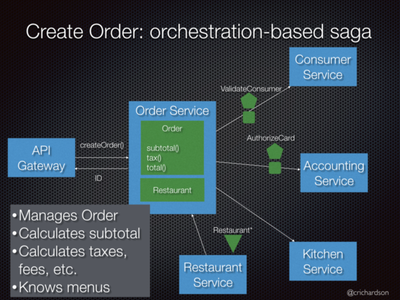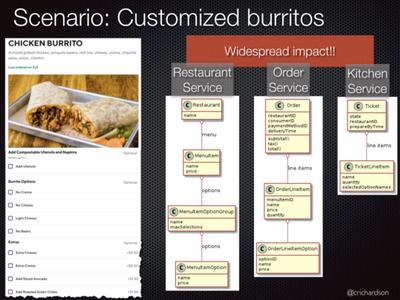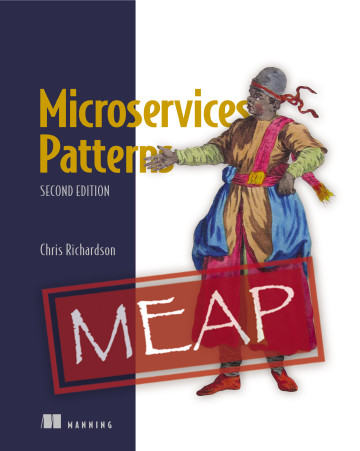Icebergs, the Interface Segregation Principle and microservices
application architecture service design service apiContact me for information about consulting and training at your company.
The MEAP for Microservices Patterns 2nd edition is now available
An essential characteristic of the microservice architecture is loose design-time coupling. In a loosely coupled architecture, changes to a service rarely require other services to be changed in lockstep. As a result, it’s easier to make changes. What’s more, teams need to spend much less time coordinating their work.
If you neglect design-time coupling, you risk creating a distributed monolith, which combines the complexity of the microservice architecture with the friction of a monolith. While such an architectural disaster might result in conference talk about why microservices are a bad idea, it could create an existential crisis for your business and is best avoided.
Services should be like icebergs
Ensuring that your services are loosely coupled requires careful design. One very helpful idea is the Iceberg principle.

A service should be like an iceberg, mostly below the waterline. Its API, which consists of operations and published events, is the visible part of the service. It should be much smaller than the service’s (hidden) implementation. That’s because what’s hidden can be easily changed. A service’s API should meet the clients’ needs while hiding much of the implementation.
When a service doesn’t look like an iceberg
Sometimes, however, a service doesn’t look like an iceberg. Consider, the takeout Burrito example from my 2021 QCON presentation on design-time coupling.
Takeout burritos version 1
There are two versions of the food ordering application. The first version looks like this:

The Restaurant Service has an API that implements <crud>Restaurant() operations and publishes Restaurant<crud> events, which contain the restaurant’s menu.
The Order Service uses the Restaurant<crud> events to maintain a CQRS replica of restaurant menus, which it uses to validate and price an orders.
This architecture seems simple.
But one drawback, however, is that the Order Service is coupled to the menu structure.
Enhancing the application to support customized burritos requires the Restaurant Service and the Order Service to change in lockstep.

Let’s look at an architecture alternative that has less coupling between the Order Service and Restaurant Service.
Takeout burritos version 2
The second version of the architecture reduces coupling by encapsulating all knowledge of the menu structure within the Restaurant Service.
Responsibility for storing, validating the line items and calculating the order subtotal is moved from the Order Service to the Restaurant Service.
The Order Service is primarily responsible for calculating fees, taxes, yet more fees and the order total.

In this version of the architecture, Restaurant Service’s API still defines <crud>Restaurant() operations.
But, instead of publishing Restaurant<crud> events, it publishes simpler RestaurantOrder<crud> events, which contain the outcome of validating and pricing the order.
The Order Service uses the subtotal from the RestaurantOrderCreated event to calculate the orderTotal.
On the one hand, the Order Service is significantly less coupled to the Restaurant Service.
It has no knowledge of a menu’s structure.
The Order Service now only consumes a very simple event that contains an outcome and a subtotal.
But on the other hand, the complexity of Restaurant Service’s API has barely changed.
It still doesn’t look like an iceberg.
Applying the interface segregation principle
An important OO design principle is Interface Segregation Principle (ISP). It states that a client should not be exposed to methods in an interface that it does not use. In other words, a class should have multiple smaller, specialized interfaces rather than one large interface. Perhaps, the same is true of services albeit for different reasons.
With the ISP in mind, another way of looking at the Restaurant Service is that it has two APIs.

The first API is Restaurant Management, which defines the <crud>Restaurant() operations.
It’s used by the Restaurant Management UI to manage restaurants.
In fact, you can think of this API as internal to the Restaurant Management capability.
Consequently, the Iceberg principle does not need to apply.
The second API implemented by the Restaurant Service is Restaurant Order Management.
This API publishes events such as RestaurantOrderCreated.
It’s used by services outside of Restaurant Management, such as the Order Service.
The Restaurant Order Management API should and, in fact, does conform to the Iceberg principle.
It’s a simple API that encapsulates the implementation details of the Restaurant Service.


 Premium content now available for paid subscribers at
Premium content now available for paid subscribers at 




